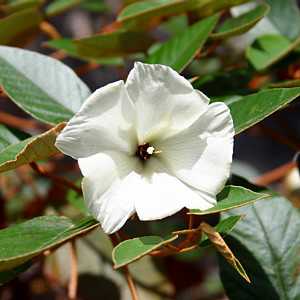⏱ QUICK READ
An early, but sadly unsuccessful, attempt at conservation, The Great Wood Wall was built to keep stray (and not-so-stray) goats and pigs from eating The Great Wood. It failed; the stones were largely robbed for other building projects. What little remains of it makes an interesting explore. On this page you can learn all about The Great Wood Wall.
SEE ALSO: The Millennium Forest ⋅ Longwood
In case anyone is confused, the ‘Great Wood Wall’ was a (stone) wall enclosing the Great Wood, not a great wall made of wood…
Some of the source material, and most of the images for this page come from John Grimshaw’s blog ‘Saint Helena 15.55 South 5.43 West’{1}.
History of the wall

Approximate extent of the Great Wood
The ‘Great Wood’ was the largest expanse of forest on St Helena and, as such, was home to an unknown number of plants, insects and birds. Its total extent seems to be lost to history but it is likely it covered an area of at around 21Km². It was located in the north-east of the island, in the area now occupied by Deadwood and Longwood, stretching as far west as Prosperous Bay Plain (the Airport site).
Sadly the demands for wood and grazing land by the early settlers brought about its almost total destruction. Learn more on our page The Millennium Forest. Removal of the trees exposed the subsoil to the elements, and in areas where the trees were entirely removed the winds quickly removed the soil, reducing the area to semi-desert.
Before it was completely destroyed, various Governors attempted to preserve it, though admittedly for economic reasons, not ecological. In 1709 Governor Roberts reported to the Court of Directors of The East India Company that the timber was rapidly disappearing, and that the goats should be destroyed for the preservation of the ebony wood. The reply was that the goats should not to be destroyed, being more valuable than the ebony.
The Records show:
In consequence, it was proposed that the remainder of the Great Wood be enclosed (‘fenced’, but by this was intended a stone structure). However the people living in the area objected, partly because they relied on the supply of wood for their cooking and partly because they were accustomed to using the Great Wood to graze their animals.
On 6th April 1723: Former Governor Pyke visited and said:
Though the enclosing of the Great Wood be extremely necessary, yet I doubt whoever does it will occasion a great deal of clamour from the people who live near it and put their cattle there, because they look on that as their own as appears by the use they make of it and the wood that is daily destroyed there.
Despite his pessimism, a project was instigated that same year to enclose the remains of the Great Wood, and between 1723 and 1727 the Great Wood Wall was built.
About 6Km² were completely enclosed, including much of Deadwood and Longwood. But the wall did not achieve its purpose. Locals simply climbed it, or broke it down in their quest for firewood and pasture.
According to the Records:
Can anyone advise us where this ‘Great Gate’ was located?
It is not known exactly when maintenance of the wall was formally abandoned. In 1733 it is reported that 10,000 trees had been removed from the area. In 1739 the enclosed area is valued at £4,500 showing some trees and non-desert land still remained. A smaller wall, for only Longwood, was proposed in 1778, but there were considerable disputes over the cost and it is not clear whether anything was actually built.
Deadwood was one of the first areas to be completely destroyed, supposedly getting its name from the resulting number of dead tree stumps.
The wall today
The images and plan{2} show the state of the wall in 2010.
Some of the decay to the wall following its disuse can be attributed to people seeking building materials.
During the building of the Airport a section of the wall came to prominence as it ran alongside the new airport access road. In August/September 2016 the St Helena National Trust decided to use their masonry skills to restore this portion of the wall.
Read More
Article: Early History of the Flora & Fauna of St Helena
By Dr. Rebecca Cairns-Wicks, published in the St Helena Herald 14th June 2002

Redwood{b}
When St Helena emerged from the sea it was completely free of animal and plant life. The natural communities that developed here were the chance collections of animals and plants, flotsam and jetsam that either flew in, were blown by the wind, or washed up by the sea. As with other remote oceanic islands, the colonising species evolved in isolation from mainland competitors adapting to local conditions and developing into unique species.
Five hundred years ago St Helena would have been a green and fertile island. Perennial streams ran in the valleys and along them grew dense thickets of Ebony. On the rocky slopes were Scrubwoods with their straggly-branched form and daisy like flowers, grey leaved Samphire, Tea plant with its wiry stems and minute leaves and flowers, the gnarled Old Father Live-Forever and the succulent Salad Plant.
At about 400-600 metres above sea level, was gumwood woodland where Gumwood and Bastard Gumwood trees were to be found with their arching branches and clusters of small flowers.
The only mammals to be found were fur seals and possibly elephant seals but birds were plentiful. The island was an important breeding site for seabirds in the South Atlantic and with at least 15 different species of seabird breeding on the Island they would have nested in their millions.
In the uplands (500-650m) where the air was cooler and moist, the Gumwoods gave way to Redwoods tall and majestic, False Gumwoods, She Cabbage trees, ferns and tree ferns. Higher still (700-823m above sea level) along the Island’s central ridge tree ferns were still common but the woodland trees were different Black Cabbage trees, St Helena Olive, Dogwood and Whitewood each unique. The white bell-shaped flowers of the large Bellflower decorated the trunks of the tree ferns, whilst a herb with flowers like a lobelia was common on the forest floor. Fragrant Jellico with its tall thick hollow stems filled the gullies of the ridge.
From early descriptions imagine how the forest looked. Thick stands of Gumwoods covered the Island between 400-600m. The shaded forest floor, littered with the decaying leaves and rich in insect life, was home to the Giant Earwig and Giant Ground beetle. But it was also the domain of the Rail, flightless, they would have foraged amongst the leaves enjoying the bounty of their extraordinarily large prey.
But, the small land area of St Helena and the relatively small numbers of individual species, makes these unique plants, animals and their habitats extraordinarily vulnerable to human disturbance from habitat destruction and modification, introduction of grazing animals and competition from invasive species. With the result that in a very short time, within 100 years of settlement, many of these unique plants and animals had either been completely destroyed or made extremely rare. The scarred eroded hills that characterise the island today are a result of human actions over the last 500 years.
Credits:
{a} Pink Floyd, from the album The Wall{b} William John Burchell
Footnotes:
{1} @@RepDis@@{2} From John Grimshaw’s blog ‘Saint Helena 15.55 South 5.43 West’{1}.


